Crane Operation of Pendent & Remote Control & Cab Control Crane
For various crane applications and opeation condtions, the overhead cranes are controlled by different types of crane control methods. Geneally, there are pendent control crane, remote control crane & cab control cranes. And also, based on your specific requirements, the overhead cranes also can be operated by different combinations of the crane controls.In the following, the the general requirements and features of the different types of crane controls are presented for your reference. If you need more information, please feel free to contact us.
Basic requirement of the on-site personnel
On-site crane operating personnel, including crane drivers, department cable crane and crane command personnel, etc. the above personnel are prerequisite for working certificate are as follows.
Basic requirement
Must guarantee the security (including oneself) of the personnel.
- Age conditions - Age above 18 years old.
- Physical qualifications. -Healthy body, the binocular vision (including vision correction) is more than 1.0, no obstruction diseases and physical defects, high-altitude vertigo in crane operations
Quality condition.
- Psychological quality: react well under the stress condition; emotional stability; responsibility.
- Cultural quality: above junior middle school.
- Technical theory quality: familiar with crane operation characteristics, and working principle; familiar with the crane composition、safety equipment and system;. familiar with the basic performance parameter of the crane.
- operation skill quality: familiar with the operation, lifting and command.
- Hoist crane operation
- Main point of hoist crane operation.
- Operation skill
Two words for the operator: Stable and accurate. Stable: crane starting, running and stopping to stability. Accurate: crane shall grant a parking position. Ruthless is disabled, ruthless is cruel operating, it’s too dangerous.
Operation safety consciousness
The safety consciousness lies in responsibility, no security responsibility, there will be no security, or it will cause accidents disasters---life or personal injury or property damage.
- Unsafe operation forms
- Disoperation: caused by lacking of safety consciousness, lack of concentration, or the unskilled technology.
- Illegal operation: Unsafe operation of violating the operating rules, because not familiar with the crane operating essentials and safety rules and other causes.
- Rough operation: It is dangerous that crane is operated irresponsibly, regardless of personnel safety or property.
- Hoist crane operation form
Ground operation / Pendent control
The ground operation of the hoist crane is by manual push button switch, also called the flashlight door control. The flashlight door use the soft rubber line and the reinforced steel wire to hang under the crane, and 1~1.2m from the ground is preferred. The flashlight door through the turn on and off of the electromagnetic switch to control motor and reversing so as to reach the lifting of the lifting load, down, left and right sides operation. There are six buttons on the flashlight door, which can manipulate crane load lifting up and down, around and before and after operation. Flashlight door is equipped with mechanical interlock protection device, power switch, as well as the low voltage (36V or 42V) flashlight door and double speed flashlight door. The flashlight door button labeled as “up” “down” “left” ”right” ”before” ”after” or↑、↓、→、←、⊙、× these two markers forms.
For different installation place and different installation way, the common ground controlling pattern has the following few kinds:
- Pendent control type 1 - Fixed type pendent control
The suspended pendent control ‘s soft rubber line is in a fixed position on the crane, or fixed on the fixed cantilever. This type is applicable to with small span, and long-term fixed obstacles, the operator will take this kind of operation when the horizontal displacement are limited to a certain extent.
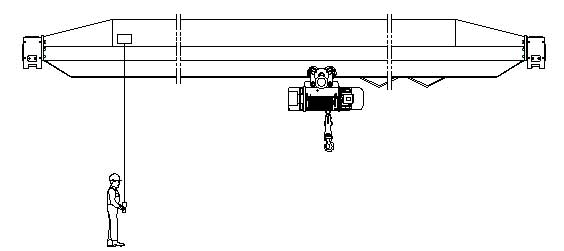
Fixed type pendent control , fixed on one side of the main girder
- Pendent control type 2 Pendent control by travelling with the movement of hoist
Pend pend control is through the soft rubber spring suspension under electric hoist control box. Operator must follows when manipulate the hoist load laterally or vertically, this manipulation form is commonly used to form ground controlling, its advantage is operator is close to the hanging load, and can see that trouble clear and repair quickly.
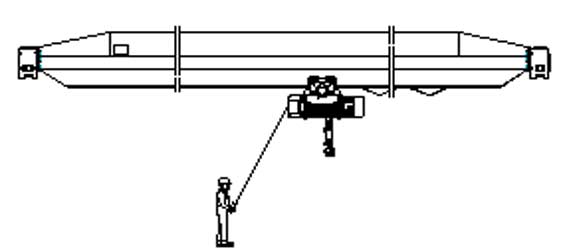
Pendent control connected with electric hoist travelling with the hoist
- Pendent control type 3 - pendent not connnected wtih the hoist
Supported by crane bridge fixed slide, the slide consists of different rolling open channel steel, roll groove is equipped with a number of small sports car suspension with flat cable or round cable, the cable end connected to a control box, the other end hang a flashlight under the trailer door. Operator hand flashlight, through a small pulley lateral movement within the groove, like the curtains to move freely, the manipulation is flexible. This kind of manipulation mode can be according to actual needs of the operators and the crane load distance, which is safe and convenient.
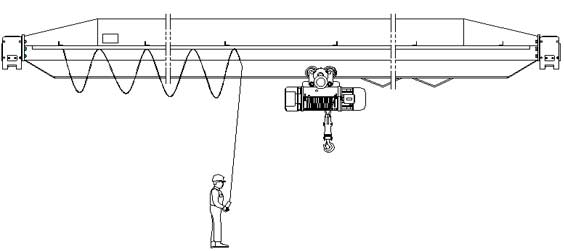
Pendent control type 3 - pendent not connnected wtih the hoist
Cab control
The cab control is one of the operation mode of the hoist gantry crane, to prevent electric shock danger, the driver’s room should be installed in the power supply side of slide wire. When the crane lifting speed is no more than 45m/min, the cab room is needed, and according to need , the driver room is divided into: open and close, the open way is divided into: side and end open.
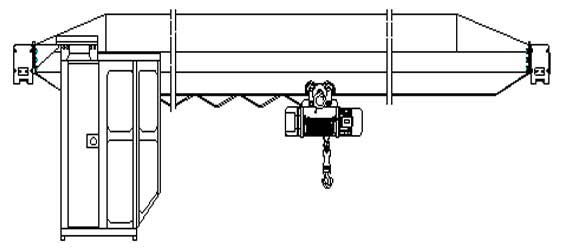
Cab control
Remote control
When the operation environmental condition doesn’t allow the operator to push the suspension flashlight door button, or doesn’t allow mobile from the horizontal movement, the operator as well as the hoist crane should respectively according to the specific place watching crane movement, while the control button or control console button to make the crane operate.
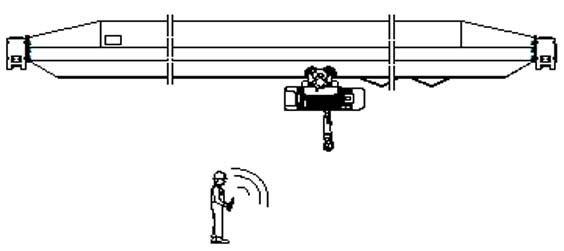
Remote control
- Driver’s daily inspection and maintenance work
(1)remove dirt
- Wipe the cab glass to ensure good field of vision
- Clean the cab to keep a good working environment.
- Clean up the dust, oil pollution, water pollution in the walkway and ladders.
- Clean whether there is a dirt track and barriers regularly.
- Clean the dirt dust on the electrical appliances .etc.
(2)Good rust prevention work
- Active view on electrical appliances , wire and cable corrosion situation, in case of leakage accident.
- Active view bare wear at the wear condition.
- Active check at the lubrication point
- Active view the paint leakage condition.
(3)Pay attention to the abnormal phenomenon in operation.
Abnormal sound – gnawing track sound, crash, friction noise and electromagnetic noise, etc. The abnormal sound -- gnawing track
- Pay attention to unusual shock, vibration and swing.
- Pay attention to slip the hook, the extent of the slide.
- Pay attention to the abnormal temperature rise or sparks, etc.
- On–site command signal
- Command signal applicable personnel: crane driver, lifting operation command personnel, lifting operation department personnel.
(2) Crane lifting command signal types
- arm signal
Use palm, fingers and arms of different position to command crane operation.
- The main points of arm signal: Forward signals-refers to the crane to the commander, Backward signals-refers to the crane leave controllers. The before, after, left and right, in command language, are based on location of the driver.
- Semaphore signals
Command in red and green flags on both sides, is mainly used in the outdoor homework mobile crane.
- Audible signal
Cooperate with hand signals or semaphore signals command with the whistle, microphone, or ring, etc.
- Commander requirement:
The command signal must be clear and accurate. The commander should look at the driver. the commander’s position should be reasonable, the driver can see clearly, and also keep a safe distance with suspended load.
- Driver’s requirements.
If command signal is not clear, referrals signal should be issued, the with Ringtones - two short statement shows; if commanding officers send the wrong command signal, the driver has the right to refuse to perform; drivers issued an emergency stop signal should obey anyone.
- Common hand signal.
Such as the following figures.
- preparatory signal
Stretch arms straight on overhead, five fingers naturally outstretched, palms facing forward remain intact, as the Figure 7-1
- The main hook signals.
Single hand punch natural, placed in the head, and touch your head, as the Figure 7-2
- o the auxiliary hook signal
Fist with one hand, forearm fixed upward, the other hands out, palms touch beforehand elbow, as the Figure 7-3.
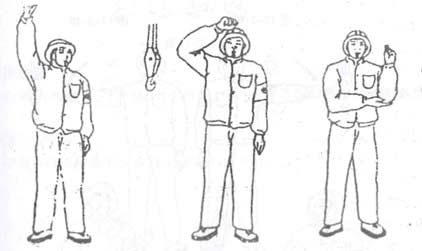
Figure7-1 Figure 7-2 Figure 7-3
- Hook up signal
The forearm to the lateral unbend, five fingers naturally stretches above the shoulders, wrist as the axis of rotation, as the Figure 7-4.
- Hook down signal
Arm into lower low, with the body angle of 30°, five fingers stretch naturally, regard the wrist as the rotation, as shown in Figure 7-5.
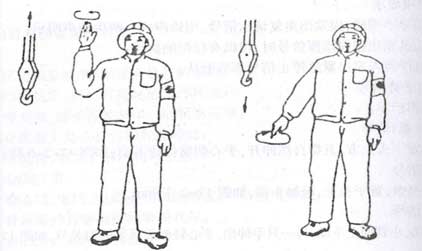
Figure7-4 Figure7-5
- Hook horizontal movement signal
The forearm to the the lateral unbend, five fingers together palm outwards, towards the direction of the load should run, waving down to the position of the shoulder , as shown in Figure7-6.
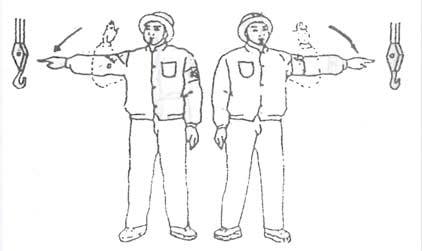
Figure7-6
- Hook slightly up signal
The forearm to the lateral upper part, palms up and higher than the shoulders, regard the wrist as the axis, repeat swing untoward palm, as shown in Figure 7-7.
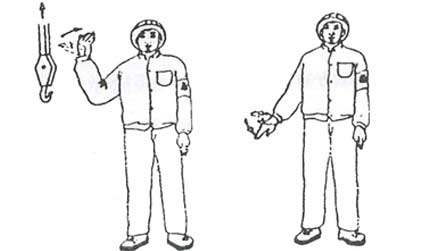
Figure7-7
- Hook slightly down signal
Arm into below before side, with the body angle is about 30°, palms down, the wrist for axis, and repeat swing the palm down as shown in Figure 7-7.
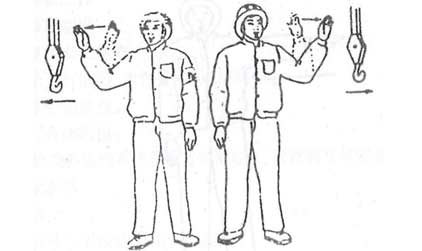
Figure7-8
- Hook slightly horizontal movement signal
The forearm to the lateral upper part, five fingers together to the outwards to the direction of load running, do the horizontal movement slowly and repeat, as shown in Figure 7-8.
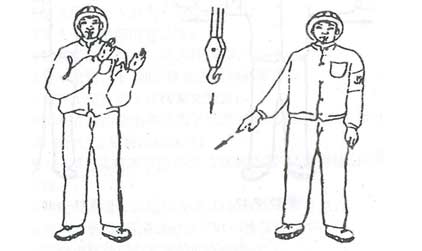
Figure7-9 Figure7-10
- Slightly move scale signal
Both forearms tune to one side and five fingers stretch, palms relative, the spacing and the distance to move close to the load, as shown in Figure 7-9.
- Landing position signal
Five fingers stretch, and point out the landing location, as shown in Figure 7-10.
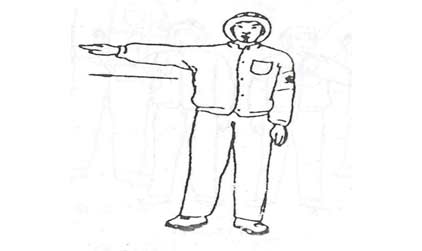
Figure7-11
- Stop signal
Lay the forearm in front of bosom levelly, and five fingers stretch, palms down, and sweep to one side, as shown in Figure 7-11.
- Emergency stop signal
Lay the forearms in front of bosom levelly, and five fingers reach down, palms down, and the sweep both sides horizontally at the same time, as shown in Figure 7-12.
- End of the work
Hands open and cross in front of the forehead, as shown in Figure 7-13.
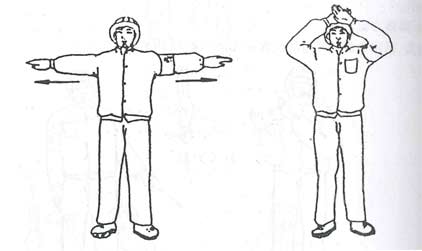
Figure7-12 Figure7-13
Crane safety operation procedures
The preparation before operation safety
- Strictly abide by the system of succession.
- Must check the security before driving.
- Check whether there is oil pollution, water pollution, orbit or obstructions.
- Check whether the crane load channel is smooth.
- switch the power when everything is normal.
- Empty test run, check the system operation whether there is abnormal phenomenon, check the brakes and other devices safety.
Operation security considerations.
- No overload lifting.
- No lifting under the command signal is unknown or violates the rules and regulations.
- no suspension tilt hanging
- Not allowed to use a device for lifting the parking
- No buffer and stop (resistance ) in normal operation, or to achieve the purpose of parking.
- No adjustment of brake in operation or maintenance/repair work.
- No lifting operation in not clear condition.
- No lifting bundled rickety suspended load.
- No running with the three institutions at the same time.
- No hanging delivery charge from other researchers on the top of the head through or stranded.
- No lifting edges in unprotected items.etc.
- No lifting when there is violent vibration, transverse and longitudinal.
- No lifting without knowing the lifting load, such as a hanging embedded objects and suspension.
- No random tearing down of any safety device on the hoist.
- No operation in the safety defects and damage situation like: brake failure, limit device failure, hook nut lick device damage, and the damaged wire rope.
- No operation under the following situation: bundling hanging, hanging load imbalance and no pad between the weight edges and the wire rope.
- Note whether there are other operator near the hanging load to prevent the collision accident.
- Note that: hanging load in a narrow place, no blind operation in the easy to dump position.
- Observe the front, back, left security when working.
- Confirm the operation is easy to see during operation.
- Confirm the flashlight door button tag before running.
- Confirm the spreader or hoisting rope was not really in hoisting hanging without with other objects, and then press the starting button.
- Contact with the security personnel timely about the trouble shooting and hidden dangers.
- Cutoff the power the moment failure occurs
- Do the little height test when the load is close to or reach the rated load, do the hoisting and lifting after the short-distance lifting test is steady.
- Stop and watch if it is safe when the heavy load is in 300mm high.
- Hoist crane without falling limiter, when the hook is in the lowest position, the wire rope on the drum must be more than twice the safety ring.
- When flipping the suspension load, the operator must stand on the reverse side of the turning direction, confirm that there is no people at the flip directions.
- Adopt the reverse movement control to reduce load swing and hit.
After work safety responsibility.
- Rise the hook up to the limit position without hanging load.
- Cart stops in a fixed position, the car stops at a position away from the power sliding contact line.
- When the hook is grab bucket or magnetic chuck, the hook should fall to the ground.
- Make the handle back to zero after parking, close the emergency switch before get off.
- Do the shift work record.




